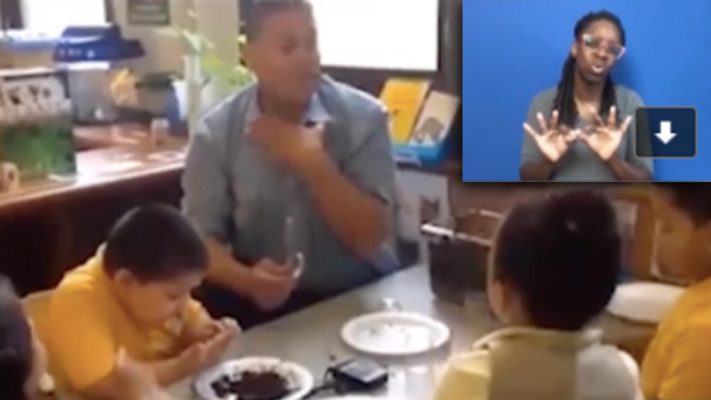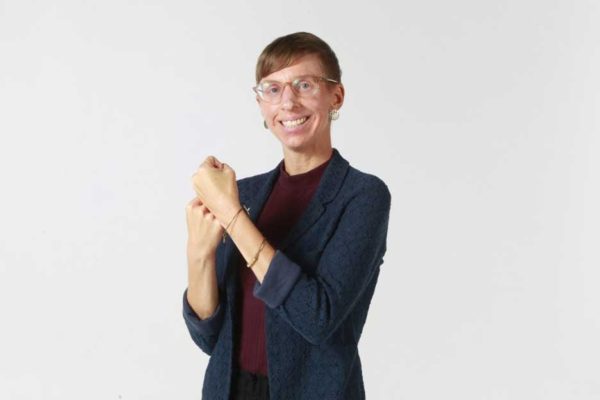
By John Cavanagh
October, National Disability Employment Awareness Month, (and the other eleven months, as well) heralds the perfect time to highlight the benefits that individuals with disabilities can offer the workforce. Often, their personal experiences give them insight and awareness that is valuable to their work and to their colleagues. This is certainly true in the growing profession of Deaf interpreters. Deaf interpreters (“DIs”) are communication specialists who provide American Sign Language (ASL) interpretation and translation, transliteration, and numerous different tactile and visual forms of communication for consumers who are Deaf, hard-of-hearing, and Deafblind.
A Deaf interpreter most often works in conjunction with a sign language interpreter who can hear. The hearing interpreter relays a message from a speaker to the Deaf interpreter. The DI then interprets the message to the Deaf consumer, conveying a far higher degree of linguistic and cultural nuance than could otherwise be achieved. A DI’s experience and expertise might be required to provide interpretation for Deaf individuals with language delays, cognitive impairments, or those who use idiosyncratic non-standard signs or gestures particular to a given region, ethnic or age group. Some fluent users of ASL also prefer Deaf interpreters.

Michael Sullivan, Director of Sonas Health Communications and Stephanie Hakulin, Deaf interpreter
Michael Sullivan, Director of Sonas Health Communication explains: “Deaf Interpreters have tremendous cache within the Deaf community. There is a lot of respect for the service. A lot of appreciation. Any company or organization that makes a DI available, immediately signals that they ‘get it.’ And there is a push to expand DI services, particularly in areas like training hearing interpreters; interpreting for post-secondary instruction, or deaf-studies classes; interpreting in the courts or in medical facilities; working with Deaf immigrants. Any communication that calls for flexibility or finesse – that’s when you definitely want a Deaf Interpreter there.”

Michael Sullivan, Director of Sonas Health (L) and Rodney Hall, Deaf interpreter
For Bridge Multimedia, a New York City-based social enterprise, precision and finesse are absolute requirements. When Bridge was recently contacted to produce STEMIE FEST, an accessible week-long live/virtual conference hosted by the University of North Carolina, Bridge CEO and Chief Creative Officer, Matthew Kaplowitz immediately thought Deaf interpreters were appropriate for the event. Kaplowitz explains, “The conference was run by the STEM Innovation for Inclusion in Early Education Center and funded by the U.S. Department of Education Office of Special Education Programs. Both these organizations have an absolute commitment to inclusion and the highest quality accessibility services. I knew they would be excited to have Deaf interpreters.”

Stephanie Hakulin, interpreting one of the online STEMIE Fest sessions
Dr. Chih-Ing Lim, the co-director of STEMIE said “Our center is focused on the inclusion of children with disabilities. For us, having these accommodations at our conference enabled us include the widest range of our audience.” Dr. Lim said that she has recommended the Deaf interpreters to colleagues for future projects. Michael Sullivan, of Sonas, was retained to facilitate Deaf interpretation for the STEMIE FEST Conference. Sullivan signed to the Deaf interpreter, who then provided interpretation informed by experience steeped in a first-hand awareness of the Deaf community, accessibility, and special education requirements. This process was conducted remotely through Zoom, an example of how technology is expanding employment opportunities for Deaf interpreters.

Dr. Chih-Ing Lim, PhD, Co-Director, STEMIE Center
According to the U.S. Bureau of Labor Statistics, the employment of ASL interpreters is projected to grow due to the increasing use of remote video services including Zoom and Skype, which allow people to conduct online video calls and use sign language interpreters. According to the U.S. Department of Labor’s Occupational Outlook Handbook, “Interpreters for the deaf will continue to have favorable employment prospects because there are relatively few people with the needed skills.” Little statistical information is currently available regarding Deaf interpreters, however many people working with them professionally believe that DI services will be increasingly in demand.
Allie Rice is the Director of Employment Services, Deputy Director of Deaf Community Services of San Diego, and a member of the Deaf community. She sees an increase in the use of Deaf interpreters due to a greater public awareness of the service, and the demand for it by the Deaf community. Ms. Rice recommends that employers who seek to hire Deaf interpreters contact their local sign language interpreter agency. According to Ms. Rice, “If the local agency doesn’t have a Deaf Interpreter within the immediate community available, they can usually locate one. Also, the Registry of Interpreters for the Deaf, RID, is a national resource that is available.”

Allie Rice, Director of Employment Services and Deputy Director of Deaf Community Services of San Diego, signs the word for “advocacy.” (Eduardo Contreras/The San Diego Union-Tribune)
Ms. Rice and Mr. Sullivan emphasized the importance of the emergence of Deaf interpretation. According to Rice, “I believe that Deaf Interpreters, with their deep understanding of the history and culture of the Deaf community, will soon become one of the top requests for accessibility.” Sullivan added, “Not only is Deaf interpretation an opportunity for well-paying employment, it’s also a type of cultural elevation, enhancing the quality of signing, as a communication form.”
To learn more, visit:
Bridge Multimedia
Deaf Community Services of San Diego
Registry of Interpreter for the Deaf
Sonas Health Communication
The STEM Innovation for Inclusion in Early Education (STEMI2E2) Center
U.S. Dept. of Labor, Occupational Outlook Handbook, Interpreters and Translators

